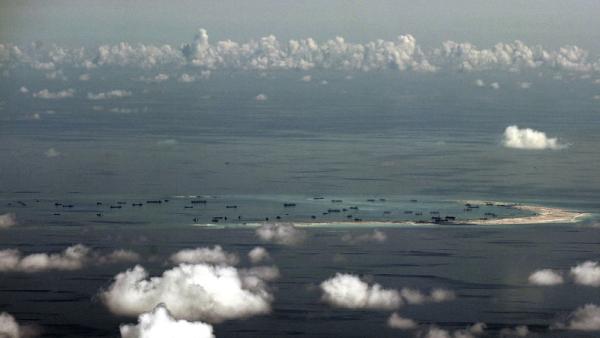The joint statement from AUSMIN 2015 commits Australia and the US “to pursue enhanced naval cooperation across all domains, including additional combined training and exercises…”[1]
This language is identical with the language of joint statements from AUSMINs each year from 2011.
In 2011 the statement said the two countries had refined and assessed “a range of potential cooperative initiatives”[2] that included options for greater use by the United States of Australian ports and options for joint activities in the region.
In 2012 the relevant paragraph said:
“We also discussed potential opportunities for additional naval cooperation at a range of locations, including HMAS Stirling.”[3]
In 2013 both sides “also agreed to continue examining opportunities for future naval cooperation in Australia.”[4]
In 2014 the relevant paragraph read:
“They discussed the potential for additional bilateral naval cooperation and welcomed the significant, wide-ranging series of port visits planned for 2015. They also asked their respective officials to develop practical options to enhance naval training and exercises in Australia and the region.”[5]
In 2015 in Boston the statement read:
“They also decided to pursue enhanced naval cooperation across all domains, including additional combined training and exercises to strengthen both countries’ capacity to conduct maritime domain awareness and amphibious operations.”[6]
In discussing the Asia-Pacific the communiqué expressed “strong concerns over recent Chinese land reclamation and construction activity in the South China Sea.”[7]
The statement went on to call on all claimant states to “halt land reclamation, construction and militarisation” and “urged claimants to exercise restraint, take steps to ease tensions and refrain from provocative actions that could escalate tensions.”[8]
The statement also called on governments to “clarify and pursue territorial claims and accompanying maritime rights in accordance with international law, including the UN Convention on the Law of the Sea (UNCLOS).”[9]
It also called on ASEAN and China to cooperate and commit to lawful use of the sea and associated freedoms.
This language is identical with that used by then-Defence Minister Kevin Andrews at the Shangri-La Dialogue on May 31 this year. Minister Andrews reiterated Australia’s opposition to any coercive or unilateral actions to change the status quo in the South China Sea; specifically nominated “any large scale land reclamation” by claimants; expressed particular concern at the prospect of militarisation of artificial structures; addressed the need for cooperation between ASEAN members and China on a code of conduct; called for restraint and a halt to reclamation activities and action to ease tensions; invoked freedom of navigation.[10]
Similar language had been used by the Abbott Government in response to the tension between China and Vietnam over China’s positioning of a deep-water oil rig in the South China Sea in May 2014. The Department of Foreign Affairs and Trade issued a release stating, “Australia does not take a position on competing claims in the South China Sea... Australia urges parties to exercise restraint, refrain from provocative actions that could escalate the situation and take steps to ease tensions.”[11]
The language of Tuesday’s AUSMIN joint statement departs from earlier expressions in specifically nominating Chinese land reclamations and construction activity. (Prime Minister Turnbull in a 7.30 Report interview on September 21 criticised Chinese activity in the South China Sea).[12] It also notes the recent statement by China’s President that China does not intend to pursue militarisation of features in the Spratly Islands. It said it was important China follow through on this commitment.
Reports in The Australian (June 2 2015)[13] and the Sydney Morning Herald (May 15 2015)[14] had suggested that Australia was discussing naval and air exercises in disputed waters, reportedly to make points about freedom of navigation.
Peter Jennings, chair of the Abbott government’s 2015 Defence White Paper advisory panel, was reported as stating:
“The next step after asserting our position is the simple physical demonstration of it by actually sailing through the sea and airspace. If we're serious about asserting it then we'll have to do it, at some stage.”[15]
Greg Sheridan wrote:
“The Abbott Government is actively considering conducting its own “freedom of navigation” exercises near artificial islands built by China in disputed territory in the South China Sea.”[16]
There was no reference in the AUSMIN communiqué to these possibilities.
Endnotes
[1] Australian Government and US Government, Joint Statement AUSMIN 2015, October 13 2015 <http://dfat.gov.au/geo/united-states-of-america/ausmin/Pages/joint-statement-ausmin-2015.aspx>.
[2] Australian Government and US Government, Australia-United States Ministerial Consultations 2011 Joint Communiqué, September 15 2011 <http://dfat.gov.au/geo/united-states-of-america/ausmin/Pages/ausmin-joint-communique-2011.aspx>.
[3] Australian Government and US Government, AUSMIN Joint Communiqué 2012, November 14 2012 <http://dfat.gov.au/geo/united-states-of-america/ausmin/Pages/ausmin-joint-communique-2012.aspx>.
[4] Australian Government and US Government, AUSMIN 2013 Joint Communiqué, November 20 2013 <http://dfat.gov.au/geo/united-states-of-america/ausmin/Pages/ausmin-joint-communique-2013.aspx>.
[5] Australian Government and US Government, AUSMIN Joint Communiqué 2014, August 12 2014 <http://dfat.gov.au/geo/united-states-of-america/ausmin/Pages/ausmin-joint-communique-2014.aspx>.
[6] Australian Government and US Government, Joint Statement AUSMIN 2015, October 13 2015 <http://dfat.gov.au/geo/united-states-of-america/ausmin/Pages/joint-statement-ausmin-2015.aspx>.
[7] Australian Government and US Government, Joint Statement AUSMIN 2015, October 13 2015 <http://dfat.gov.au/geo/united-states-of-america/ausmin/Pages/joint-statement-ausmin-2015.aspx>.
[8] Australian Government and US Government, Joint Statement AUSMIN 2015, October 13 2015 <http://dfat.gov.au/geo/united-states-of-america/ausmin/Pages/joint-statement-ausmin-2015.aspx>.
[9] Australian Government and US Government, Joint Statement AUSMIN 2015, October 13 2015 <http://dfat.gov.au/geo/united-states-of-america/ausmin/Pages/joint-statement-ausmin-2015.aspx>.
[10] Kevin Andrews, Speech delivered at the 114th IISS Asia Security Summit: The Shangri-La Dialogue, May 31 2015 <http://kevinandrews.com.au/latest-news/2015/05/31/114th-iiss-asia-security-summit-the-shangri-la-dialogue/>.
[11] Department of Foreign Affairs and Trade, Australian Government, ‘Statement on developments in the South China Sea’ (Media Release), May 14 2014 <https://www.dfat.gov.au/media/releases/department/2014/dfat-release-20140514.html>.
[12] Interview with Malcolm Turnbull, Australian Prime Minister (7.30 Report, ABC, September 21 2015) <http://www.abc.net.au/7.30/content/2015/s4316975.htm>.
[13] Greg Sheridan, “Flight exercises to test China waters”, The Australian, June 2 2015 <http://www.theaustralian.com.au/national-affairs/foreign-affairs/flight-exercises-to-test-china-waters/story-fn59nm2j-1227378837148>.
[14] John Garnaut and David Wroe, “Australia urged to send military to counter China’s control over sea lanes”, Sydney Morning Herald, May 15 2015 <http://www.smh.com.au/federal-politics/political-news/australia-urged-to-send-military-to-counter-chinas-control-over-sea-lanes-20150515-gh2uks.html>.
[15] Peter Jennings quoted in John Garnaut and David Wroe, “Australia urged to send military to counter China’s control over sea lanes”, Sydney Morning Herald, May 15 2015 <http://www.smh.com.au/federal-politics/political-news/australia-urged-to-send-military-to-counter-chinas-control-over-sea-lanes-20150515-gh2uks.html>.
[16] Greg Sheridan, “Flight exercises to test China waters”, The Australian, June 2 2015 <http://www. theaustralian.com.au/national-affairs/foreign-affairs/flight-exercises-to-test-china-waters/story-fn59nm2j-1227378837148>.


